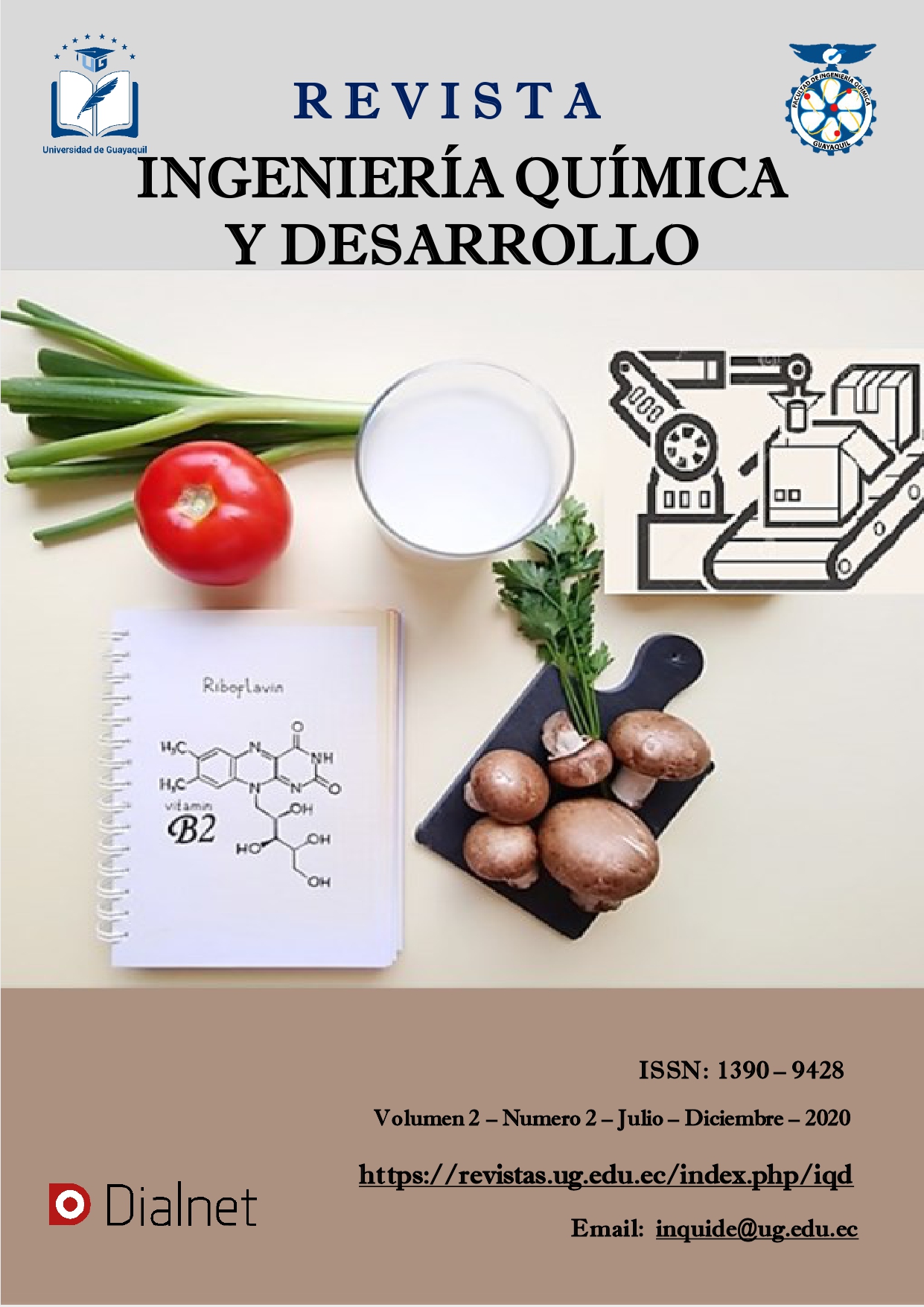Development of an alcoholic beverage based on sweet cucumber (Solanum Muricatum), for application in cocktails
Main Article Content
Abstract
The present work is focused on the alcoholic fermentation of sweet cucumber (Solanum Muricatum) for its subsequent implementation in the cocktail bar. Based on the foregoing, bibliographic studies were carried out to obtain information that supports the creation of the three experimental designs developed, by means of a quantitative methodology; had a fermentation time of twenty days, measuring pH, temperature, Brix degrees and their alcoholic content. The results achieved were led to an analysis of the aromatic profile of attributes, which gave the effect that their correct temperature ranges between 14 and 16 ° C, highlighting citrus and fruit aromas, greatly facilitating combinations of the realization of the cocktails, which were subjected to a hedonic test, concluding that the product with greater acceptability is the cocktail by direct method of tree tomato and grape.
Metrics
Article Details

This work is licensed under a Creative Commons Attribution-NonCommercial-NoDerivatives 4.0 International License.
Esta revista provee acceso libre inmediato a su contenido bajo el principio de que hacer disponible gratuitamente investigación al publico apoya a un mayor intercambio de conocimiento global.
Usted es libre de:
- Compartir — copiar y redistribuir el material en cualquier medio o formato.
Bajo los siguientes términos:
- Atribución — Usted debe dar crédito de manera adecuada, brindar un enlace a la licencia, e indicar si se han realizado cambios. Puede hacerlo en cualquier forma razonable, pero no de forma tal que sugiera que usted o su uso tienen el apoyo de la licenciante.
- NoComercial — Usted no puede hacer uso del material con propósitos comerciales.
- SinDerivadas — Si remezcla, transforma o crea a partir del material, no podrá distribuir el material modificado.
Derechos de autor
Los autores que publican en Ingeniería Química y Desarrollo conocen y aceptan las siguientes condiciones:
- Los autores retienen los derechos de copia (copyright) sobre los trabajos, y ceden a Ingeniería Química y Desarrollo el derecho de la primera publicación del trabajo, bajo licencia internacional Creative Commons Atribución-NoComercial-SinDerivadas 4.0 que permite a terceros compartir la obra siempre que se indique su autor y su primera publicación esta revista.
- Los autores conservan los derechos de autor y garantizan a Ingeniería Química y Desarrollo el derecho de publicar el trabajo a través de los canales que considere adecuados.
- Los autores son libres de compartir, copiar, distribuir, ejecutar y comunicar públicamente la versión del trabajo publicado en Ingeniería Química y Desarrollo, haciendo reconocimiento a su publicación en esta revista.
- Se autoriza a los autores a difundir electrónicamente sus trabajos una vez que sean aceptados para publicación. No se permite el uso comercial de copia o distribución de contenidos, así como tampoco la adaptación, derivación o transformación alguna de estos sin la autorización previa de los autores y de Ingeniería Química y Desarrollo.
References
A. Álvarez Rodríguez, A. Campo Costa, E. Batista Ricardo y A. Morales Miranda, «Influencia del Humus por vía Foliar en el desarrollo vegetal del cultivo del Pepino (Cucumis sativus L) en la Unidad Básica de Producción Cooperativa (UBPC) "El Jardín",» Ciencias Holguín, vol. 15, nº 2, pp. 1-10., 2010.
G. Puerta, Fundamentos del Proceso de Fermentación en el Beneficio del Café, S. M. M. L., Ed., Chinchiná, Caldas: Cenicafe, 2013, p. 12.
E. Z. Vega, «Producción de Alimentos por Actividad Bacteriana – Fermentación,» Universidad de Puerto Rico, p. 12, 2017.
R. Parada Puig, «Lifeder,» Lifeder, 29 04 2020. [En línea]. Available: https://www.lifeder.com/fermentacion/.
R. W. McGilvery, Effect of glucose concentration in the growth medium upon neutral and acidid fermetation, Philadelphia, 1977, p. 7.
L. J. Turton, D. B. Drucker y L. A. Ganguli, «Effect of glucose concentration in the growth medium upon neutral and acidic fermentation end-products of Clostridium bifermentans, Clostridium sporogenes and peptostreptococcus anaerobius,» J Med Microbiol, vol. 16, nº 1, 1983.
G. Moreno-Arcuri y Á. D. López-Mota, «CONSTRUCCIÓN DE MODELOS EN CLASE ACERCA DEL FENÓMENO DE LA FERMENTACIÓN, CON ALUMNOS DE EDUCACIÓN SECUNDARIA,» Revista Latinoamericana de Estudios Educativos (, vol. 9, nº 1, pp. 53-78, 2013.
Gutiérrez, «Clases de Fermentaciones,» 2016. [En línea]. Available: http://aulavirtual.agro.unlp.edu.ar/pluginfile.php/19335/mod_resource/content/2/5. Clase Fermentación 2016.pdf. [Último acceso: octubre 2018].
Y. E. Mora Dután, «MODELACIÓN CINÉTICA DE LA FERMENTACIÓN ALCOHÓLICA DEL ZUMO DE POMARROSA,» UNIVERSIDAD CENTRAL DEL ECUADOR, Quito, 2014.
P. Steinkraus y K. H. Steinkraus, «Fermentations in World Food Processing CRFSFS,» Comprehensive Reviews in Food Science and Food Safety, vol. 1, p. 429, Noviembre 2006.
L. Carrillo, M. C. Audisio, N. d. V. Bejarano, G. Molina y E. G. Ancas, Manual de Microbiologia de los Alimentos, vol. 1, San Salvador de Jujuy: Asociación Cooperadora de la Facultad de Ciencias Agrarias, 2007.
M. J. Ribeiro, A. Renos, T. Boller, A. Wiemken y C. De Virgilio, «Trehalose synthesis is important for the acquisition of thermotolerance in Schizosaccharomycespombe,» Molecular Microbiology, vol. 25, nº 3, pp. 571-581, 1997.
1. INEN 1529-10, CONTROL MICROBIOLÓGICO DE LOS ALIMENTOS. MOHOS Y LEVADURAS VIABLS. RENCUENTO EN PLACAS POR SIEMBRA EN PROFUNDIDAD, Quito, 1998.
J. A. Mejía Barajas y A. Saavedra Molina, Conociendo las levaduras, 2015.
E. E. Fajardo Castillo y S. C. Sarmiento Forero, «Evaluacion de la melaza de caña como sustrato para la produccion de Saccharomyces Cerevisiae,» Pontificia Universidad Javeriana, Bogota, 2007.
C. Padín González y M. Díaz Fernández, «Fermentación alcohólica del lactosuero por Kluyveromyces marxianus y solventes orgánicos como extractantes,» Revista de la Sociedad Venezolana de Microbiología, vol. 29, nº 2, pp. 110-116, 2009.
L. M. Solís, Artist, Fermentacion Alcoholica. [Art]. 2016.
R. Alfaro Solís, J. Valdés González, J. P. Sibaja Brenes y G. Esquivel Hernández, «DISEÑO DE UN MÉTODO DE ANÁLISIS ESPECTROFLUOROMÉTRICO, PARA LA DETERMINACIÓN DE ETANOL EN AIRE,» Uniciencia, vol. 27, nº 1, pp. 215-231, 2013.
NTE INEN 2870, «Trazabilidad en la Cadena Alimentaria Frutas y Hortalizas: Requisitos,» p. 7, 1992.





